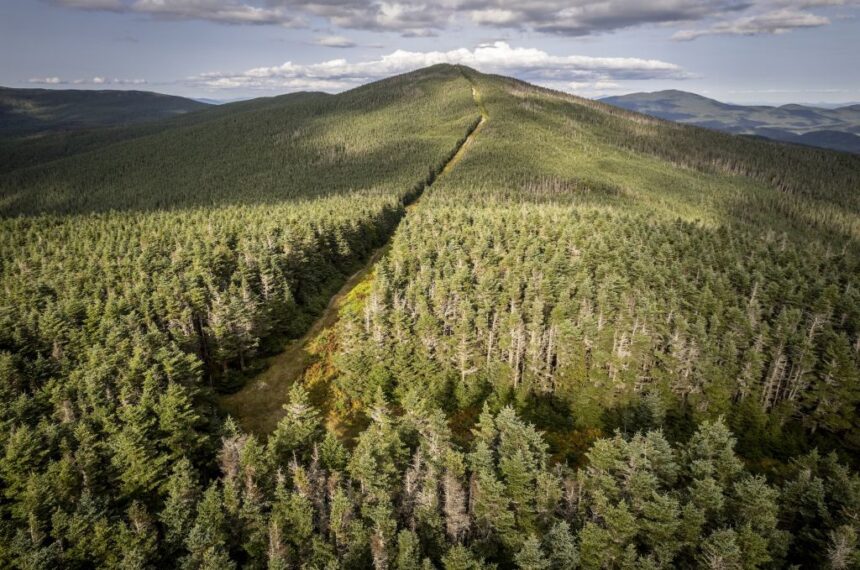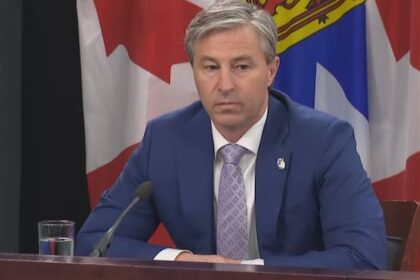On the border between the United States and Mexico, a black bear paces back and forth when confronted with the looming steel beams that form the border wall between the two countries. A pack of javelina wriggles through a tiny opening barely bigger than a piece of printer paper. But on the border between Canada and the U.S., the picture is very different. In many places, moose, bear, wolves and other wildlife can simply walk between the two nations. There are barriers — roads, development and a lack of protected habitat on either side — but for more than a century, relatively relaxed border policy and a shared sense of purpose saw conservationists in both countries working together to overcome them. Now, U.S. President Donald Trump has ratcheted up the challenges to cross-border conservation. Since his election, he has threatened Canadian sovereignty, sowed economic jeopardy on both sides of the border and cancelled, or proposed cancelling, many U.S. research grants for conservation work. Bears cross borders without a second thought, like this pair in Waterton Lakes National Park, along the U.S. border in southwestern Alberta. Geopolitical turmoil may not impact wildlife at the border directly, but it has big implications for cross-border conservation efforts. Photo: Ryan Peruniak Many of Trump’s actions have explicit implications for cross-border conservation — in North America and globally. Early on in this term, Trump, along with Elon Musk, then at the helm of Trump’s Department of Government Efficiency, all but shut down USAID and its international conservation efforts. Canadian conservation organizations have reported losing co-funding as a result of Trump’s cuts to foreign aid. As his administration has stretched staffing thin and proposed deep budget cuts at the U.S. National Park Service, it ended funding many found crucial to habitat conservation work across the border. Trump has also withdrawn from the Green Climate Fund and the Paris Agreement — both of which support co-operative global action on climate change — and has signalled he wants to cut the Multinational Species Conservation Fund. The Great Lakes Environmental Research Laboratory, which monitors aquatic health on both sides of the Canada-U.S. border and is part of the National Oceanic and Atmospheric Administration, has also been gutted. Other impacts on Canadian conservation are more subtle. As stories of tightening border security spread online, many professionals fear crossing the border for business purposes, no matter how legitimate and lawful they may be. Not to mention the visceral chill in many Canadians’ perception of their closest neighbour. Despite the challenges, Canadian organizations doing cross-border work are carrying on. “In some ways, nothing has changed for wildlife. Wildlife are still free to cross the boundaries,” said Jodi Hilty, the president and chief scientist of the landscape connectivity initiative Yellowstone to Yukon Conservation Initiative (Y2Y), which aims to create an uninterrupted wildlife corridor through that region. But Trump has also cast a cloud of uncertainty over efforts to establish connected habitat across the two countries’ national boundaries, and conservation organizations are navigating uncharted waters. An international science conference in the U.S. highlights declining Canadian participation Cross-border collaborations rely on relationships. Putting private land into a conservation easement — a legal designation that can prevent development in perpetuity — or securing wildlife movement data comes down to individual relationships between scientists, conservationists and land owners. Yet, many people working in conservation have expressed anxieties that Trump’s attacks on Canadian sovereignty and increased concern about the perceived risks of crossing the border are stymying those critical connections. “We saw the biggest impact at our biannual science symposium,” Jessica Lax, the executive director of the Algonquin to Adirondacks Collaborative, said in an interview. The group aims to protect corridors for wildlife movement between the two eastern U.S. and Canadian parks, similar to Yellowstone to Yukon’s efforts to the west. The group hosts a conference every other year, alternating between nations. In 2025, the collaborative held its conference in upstate New York. Many Canadians couldn’t or wouldn’t attend — out of the 80 people in attendance, Lax said, only 10 to 15 were Canadian, less than half the expected representation. The event is just as much about sharing research and management strategies across the border as it is about building face-to-face connections with others in this line of work, Lax said. She worries that because a smaller group of Canadians attended this year, some of those foundational connections were not made. “It’s a subtle thing that now runs through a lot of the work that will make things a little bit harder, because those relationships weren’t strengthened.” Waterton Lakes National Park in Alberta and Glacier National Park in Montana meet at the Canada-U.S. border, and together they form the Waterton-Glacier International Peace Park. Shaking hands across the border is a common practice that symbolizes the two countries’ shared goal of peace. Photo: Parks Canada / Facebook Hilty cites Waterton Lakes National Park in Alberta and Glacier National Park in Montana, which together form the Waterton-Glacier International Peace Park, as an example of the importance of maintaining relationships. There, every year, Canadian and American members of the global organization Rotary International shake hands and recite the “peace pledge.” “May the long-standing peace between our nations stimulate other peoples to follow this example.” Hilty calls this type of effort “positive peace.” “Positive peace is an active intent to work together,” she explained, one that extends across borders and barriers. She sees Yellowstone to Yukon’s work in this light. The organization is technically two non-profits, one Canadian and one American, working in concert. That process demands constant interaction and proactive co-operation between two countries — not just internally, among board members and staff, but also with the community groups and landowners in the Yellowstone to Yukon region, Hilty says. “I think movements like [Yellowstone to Yukon], and these transboundary efforts are not just hugely important just for nature, but they are also really important for society,” Hilty said. “How do we lean in and maintain and build relationships during this time when governments are having all this tension? How do we keep it at the community level?” Local governments, international movement For Yellowstone to Yukon, keeping things at the community level — through connections with tribal governments and private landowners — has made progress despite the political climate. Nowhere has that been more apparent than their work with the Blackfoot Confederacy to bring free-ranging bison back to the West, through a project called the Iinnii Initiative. “There’s a lot around this idea of sharing bison and erasing this artificial line and restoring a free-ranging, or a semi-free-ranging, herd,” Hilty said. The cross-border conservation group Yellowstone to Yukon is supporting the Blackfoot Confederacy’s efforts to reintroduce free-ranging bison to the landscape. Photo: Gavin John / The Narwhal Guardians in the Blackfeet Buffalo Program now tend to the small population of iinnii. The larger aim is to link tribal and public lands in a transborder corridor, where the bison can range freely — not as cattle, as most of the bison that do live on the landscape are categorized today — and restore balance to the grassland ecosystem that relies on their presence. For now, Yellowstone to Yukon is supporting the ambitions of the Blackfoot Confederacy by focusing on granular details, like working on a state level to broaden the legal designation of bison beyond the narrow classification of livestock. In the east, the Algonquin to Adirondacks Collaborative has also focused on the “nitty gritty,” in Lax’s words. Recently, the group’s focus has turned to the planned expansion of Ontario’s Highway 401, Canada’s busiest highway. They are pushing for the expansion to include the construction of wildlife crossings along the highway. The Frontenac Arch and Thousand Island region, where the highway expansion falls, has become more and more important as a conservation pathway, Lax explained. As ice in the St. Lawrence River melts, wildlife have been funnelled into a pinch point for passage as they move from north to south. The highway, Lax explained, is a huge source of wildlife mortality in this increasingly delicate region. Though she sees the environmental harm an expansion can have, smart crossings, she suspects, could actually reduce the impact the highway currently has on wildlife trying to migrate across the corridor. Though the highway sits firmly on the Canadian side of the Algonquin to Adirondacks corridor, Lax said she has received an outpouring of interest and help from American partners. “This region influences the ecosystems on the U.S. side pretty significantly,” she said. Wildlife overpasses such as this one near Calgary help make animals’ annual migrations — which often cross the Canada-U.S. border — safer. In Ontario, the cross-border conservation group Algonquin to Adirondacks is advocating for similar wildlife corridors along Highway 401 near Kingston. Photo: Jeff McIntosh / The Canadian Press Wildlife cover a lot of ground, ‘much bigger geopolitical scale’ Though working on a smaller scale has proven crucial for achieving habitat protection, for widely migrating wildlife to truly benefit, conservationists say, it’s essential to link those efforts together on a broad, transnational scale. Few are more familiar with this than bird biologists. “Focusing on one country, one state, one political jurisdiction is clearly not dealing with the biodiversity crisis. We have to be thinking at a much bigger geographic scale, which means you’re looking at a much bigger geopolitical scale,” Jeff Wells, the National Audubon Society’s vice-president of boreal conservation, told The Narwhal. Take the red knot: a small, tawny shorebird that breeds in the Arctic but spends its summers in South America. Delaware Bay, an estuary between Delaware and New Jersey, is a crucial halfway point on the birds’ journey, where they can stop to fuel up on horseshoe crab eggs. As interest in harvesting the horseshoe crabs for pharmaceutical use and bait has grown, so too has a fervent movement to protect the crabs, beach habitat and birds in Delaware Bay. But none of that matters, Wells said, if the breeding grounds in Hudson Bay and the wintering grounds in South America are not equally protected. Audubon is now working with nine Ontario First Nations to build out a marine protected area in Hudson Bay. Navigating the need for data and funding, without certainty of either Data is key to identifying areas for protection, but cuts to U.S. research funding may have jeopardized its collection, and many government databases have simply been wiped. Hilty particularly fears the loss of movement data collected by the Interagency Grizzly Bear Committee, which includes the National Park Service, U.S. Geological Service and the U.S. Fish and Wildlife Service among its members.. For now, it remains accessible on the team’s website. When it comes to grizzly bears, data that illustrates movement patterns is crucial in helping get the population of Yellowstone grizzlies connected with the genetic diversity of a larger Canadian population, Hilty explained. It allows Yellowstone to Yukon to identify priority habitat and work with ranchers and communities to ensure they are protected from development. A young grizzly fishes for salmon. Conservation advocates fear the Trump administration may cut funding for research crucial to data on grizzlies’ movement patterns. Photo: Matt Simmons / The Narwhal Losing it, she said, would mean losing access to “one of the biggest, longest-term large carnivore data sets in the world,” she said. She underscored that her team and other conservationists outside the organization are still unpacking the long-term impacts of not being able to use the full scope of information and data needed for these projects. To the east, Algonquin to Adirondacks is already feeling the impact of cuts: this spring, Lax says, a National Park Service grant that would have gone towards completing a mapping project was frozen unexpectedly. The organization’s bi-national status allowed it to secure funding from Parks Canada to cover the gaps. The work of re-orienting to the current political climate and cross-border tensions will take time, conservationists say, but so does the work of true connectivity. The timelines for a landscape and a species extend much further than the flashpoint-anxiety of any one presidential administration. “Any opportunities people have for collaboration, they should see it as even more important and meaningful than ever,” Wells said. “The work will go on. It’s essential to human life. So it doesn’t even make sense not to continue.” Recent Posts U.S. funding cuts threaten wildlife on both sides of the Canadian border Sept. 25, 2025 10 min. read Conservation groups say collaborative efforts to protect shared habitat corridors will continue, despite political tensions B.C. spent $200 million to connect one LNG plant to the electrical grid Sept. 24, 2025 5 min. read What happens when energy-intensive industries want to go electric at minimal cost? B.C. may be… A massive nickel mine, and the community that wants to love it Sept. 23, 2025 17 min. read Timmins, Ont., has a long history of mining and its economy could use another boom….
U.S. funding cuts threaten wildlife on both sides of the Canadian border












